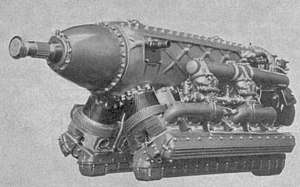Isotta Fraschini Gamma
The Isotta Fraschini Gamma was an air cooled aircraft engine developed by the Italian engineering company Isotta Fraschini in the 1930s. It was an inverted V12 rated at over 500 hp (373 kW). Produced in small numbers for single aircraft including the Ambrosini SAI.107 and Caproni Vizzola F.5 Gamma fighter prototypes, it was developed into the more powerful and more numerous Delta.
| Gamma | |
|---|---|
 | |
| Isotta Fraschini Gamma R.C.35 | |
| Type | Air cooled V12 aircraft engine |
| National origin | Italy |
| Manufacturer | Isotta Fraschini |
Design and development
The Gamma was an air cooled inverted V engine with 12 cylinders arranged in two banks, each cylinder of bore 125 mm (4.9 in) and stroke 130 mm (5.1 in).[1] Isotta Fraschini produced the Gamma in small numbers during World War II at a rating of about 500 hp (373 kW).[2]
The engine formed the basis for a number of other aircraft engines produced by the company. The more powerful Delta was developed as a larger complement to the Gamma. While the Beta straight-six engine was essentially one half of the engine, the Zeta mated two Gamma engines to a common crankshaft to create an X24 engine. The larger engines shared with the Gamma a problem cooling the rearmost cylinders which impeded development.[3]
In 1942, there was speculation in the UK about a powerful Italian engine called the Isotta Fraschini Gamma that produced 1,700 hp (1,268 kW) at 2200 rpm for take-off and had a displacement of 55.562 l (3,391 in3) with a bore of 195 mm (7.7 in) and stroke of 192.5 mm (7.58 in).[4]
Variants
- Gamma R.C.15
- 540 hp (403 kW) at 1,500 m (4,921 ft)
- Gamma R.C.35
- 515 hp (384 kW) at 3,500 m (11,483 ft)
Specifications
Data from Pearce, 2017[3] and Wilkinson, 1945[1]
General characteristics
- Type: 12-cylinder air cooled 60° inverted V aircraft piston engine
- Bore: 125 mm (4.9 in)
- Stroke: 130 mm (5.1 in)
- Displacement: 19.1 l (1,166 in3)
Components
- Valvetrain: Two valves per cylinder with dual overhead camshafts
- Supercharger: Single stage, 10.34:1
- Fuel type: 87 octane petrol
- Cooling system: Air-cooled
Performance
- Power output:
- (Take-off) 550 hp (410 kW) at 2200 rpm
- (Military) 580 hp (433 kW) at 2730 rpm at 4,000 m (13,000 ft)
- Compression ratio: 6.5:1
See also
Related development
Comparable engines
Related lists
References
| Wikimedia Commons has media related to Isotta Fraschini Gamma. |
Notes
- Wilkinson 1945, p. 297.
- Gunston 1998, p. 93.
- Pearce 2017.
- Morrison, p. 450.
- Thompson 1963, p. 15.
- Thompson 1963, p. 121.
- Brotzu, Caso, Cosolo 1972, p. 30.
Bibliography
- Brotzu, Emilio; Caso, Michele; Cosolo, Gherardo Cosolo (1973). Aerei Italiani nella 2ª Guerra Mondiale Vol.5, Bombardieri-Ricognitori (in Italian). Roma: Edizioni Bizzarri.CS1 maint: ref=harv (link)
- Gunston, Bill (1998). World Encyclopedia of Aero Engines. Sparkford: P. Stephens. ISBN 978-1-85260-597-1.CS1 maint: ref=harv (link)
- Morrison, John W. (7 May 1942). "Power Units of the Future". Flight: 447–451. Retrieved 7 September 2018.CS1 maint: ref=harv (link)
- Pearce, Willian (2017). "Isotta Fraschini Zeta X-24 Aircraft Engine". Old Machine Press. Retrieved 7 September 2018.CS1 maint: ref=harv (link)
- Thompson, Jonathan (1963). Italian Civil and Military Aircraft, 1930-1945. Los Angeles: Aero Publishers. ISBN 978-1-25844-296-5.CS1 maint: ref=harv (link)
- Wilkinson, Paul (1945). Aircraft Engines of the World. New York: Paul Wilkinson.CS1 maint: ref=harv (link)